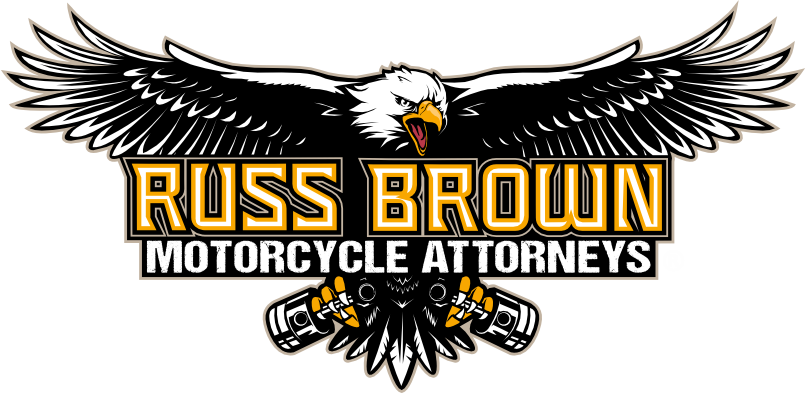Cold Tire Motorcycle Accidents
TIRE MOTORCYCLE ACCIDENTS
Any responsible motorcyclist understands the importance of safety inspections before hitting the road. Tires are where any safety inspection should start. Your point of contact with the road is an essential aspect of your vehicle. What people sometimes overlook is the effect that cold weather has on tires. Quite beside the problem of icy or damp roads, tire pressure can also be affected. Without taking appropriate precautions against changes to your tires both before and during riding, you are subjecting yourself to greater risk of a motorcycle accident, especially cold tire motorcycle accidents. Russ Brown Motorcycle Attorneys® is committed to protecting motorcycle riders, whether that’s before or after a motorcycle accident. To that end, we have some guidance from our experience as riders. Russ Brown Motorcycle Attorneys® are the original attorneys that ride, with decades of experience as the firm that invented motorcycle law as a field.
How to Prevent Cold Tire Crashes
- Assign the unique CSS ID for each hidden block. You can find this setting in “Advanced” tab.
- Assign “hidden” class for hidden block.
- Assign “readmore_button” class for the button
- Type the # character with CSS ID of hidden block in the link field of the button
For example hidden text has CSS ID “story1” and class “hidden”. Button has class “readmore_button” and link “#story1”. Enjoy!
Cold Weather Riding Tips
- When riding in cold weather, tip-overs can occur when the brake or throttle are overused. Too much braking and throttling can result in a cold rear tire breaking loose.
- When you are riding in cold temperatures and you have a passenger, be sure to adjust the PSI to accommodate the increase in weight. Check the tire manufacturer’s recommended PSI.
- Be cautious when beginning a ride in cold weather. Street rubber and road surfaces generally interface best when the tire is around 135° Fahrenheit. Starting from a temperature that is lower than normal, and with the road surface also colder, means that it will take longer for your tires to reach that temperature. Taking a turn into a corner at a lean angle before the tires are warmed up can cause a nasty spill. It’s also worth considering that the more layers of protective gear a rider wears, the likelier they are to minimize their level of injury.
- Ensure you are wearing the correct gear for the weather. At 65 miles an hour, 45° feels more like 25°, thanks to wind chill. Anything below 35° can be not just uncomfortable but actually painful without suitable attire. Stay warm by wearing base layers. Gore-Tex gear generally makes a difference, and wind-proof underlayers such as balaclavas also improve a rider’s situation. Shop around for a winter riding glove that allows lever feel without being too bulky.
- The safest riders are those who prepare for the worst on the road ahead. They scan for steel plates covering construction, for potholes in the riding lane, sand that has washed into the road. These and other hazards abound for riders during winter.
- It’s especially important in cold weather to match your front and rear tire. Brand, model, speed rating, and other factors all play a role in making your motorcycle’s tires roadworthy. Incompatible tires mean that handling problems caused by the chilly climate can be compounded. Remember that rear and front tires are marked, and have arrows indicating the direction of rotation.
The Truth Behind Cold Tires
One recurring theme of cold tire crashes are riders who don’t understand what happened. They say things like ‘I was just riding down the road when it happened.’ Chances are, there were warning signs that they overlooked or didn’t know to look for. When you’re warming up a cold bike, give it several minutes before you approach 60-70% of your usual cruising speed. Inexperienced riders will pick up on the throttle when turning into a corner, if they’re worried about their low speed. Unfortunately, this transfers more weight to the rear tire. The amount of contact on the front tire is reduced, which is a danger to a cold bike, as a bike with less road contact goes down easier. The correct response to fix this concern is to use the brake to correct. Once the bike is on the right trajectory for the corner, you can take it at the same speed. Do not accelerate until the bike is ending the corner and the upcoming roadway can be seen. At this stage, it is safe to stop the leaning angle, and pick up speed. This technique reduces the risk of cold tire motorcycle accidents.
Some riders advocate for weaving left and right in order to ‘warm’ a cold tire quickly by creating additional friction on the contact patch. However, this trick only really has an effect on vehicles that have a flat contact patch, like cars. Motorcycle tires have rounded contact patches. They lean to turn, so the friction is not generated in the same way. In truth, it is not a terribly efficient method for cars, either. There are many motorcycle riding schools that teach how to avoid this outcome via this method, and it’s one we advocate as well. Of course, you might not find it to be necessary often in Los Angeles County, but there are many areas of California where it could literally save your life.
Choose Russ Brown Motorcycle Attorneys® and Avoid the Cold Shoulder
At Russ Brown Motorcycle Attorneys®, we are proud to advocate for our fellow riders. We offer an extra level of insight into motorcycle accident law that only a real rider can. It’s this edge that has given us the advantage in so many of our cases. We have a sterling success rate of 98% in cases where we’re retained. However, we aren’t just legal attack dogs. When one of our clients suffer a motorcycle accident, we can spring into action to protect them from opportunistic insurance adjusters and other individuals who can capitalize on disoriented accident victims to save their businesses money by withholding rightful compensation. We make sure our clients are receiving the care that they need, sharing the load with them so that they don’t have to face everything alone. With priorities and results like these, we feel justified in our company motto: We Ride. We Care. We Win. Call us today to learn more about the legal services we provide and book a free consultation: 1-800-424-5377.











